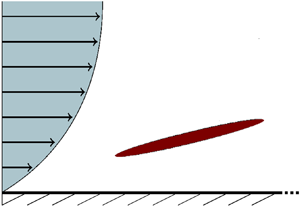Published online by Cambridge University Press: 13 October 2020

Interaction between body motion and fluid motion is considered inside a nonlinear viscous wall layer, with this unsteady two-way coupling leading to impact of the body on the wall. The present paper involves a reduced system analysis which is shown to be consistent with computational solutions from direct numerical simulations for a basic flat-plate shape presented in an allied paper (Palmer & Smith, J. Fluid Mech., 2020). The occurrence of impact depends mainly on fluid parameters and initial conditions. The body considered is translating upstream or downstream relative to the wall. Subsequent analysis focusses on the unusual nature of the impact at the leading edge. The impacting flow structure is found to have two nonlinear viscous–inviscid regions lying on either side of a small viscous region. The flow properties in the regions dictate the lift and torque which drive the body towards the wall. Pronounced flow separations are common as the impact then cuts off the mass flux in the gap between the body and the wall; here, a nonlinear similarity solution sheds extra light on the separations. Comparisons are made between results from direct simulations and asymptotics at increased flow rate.